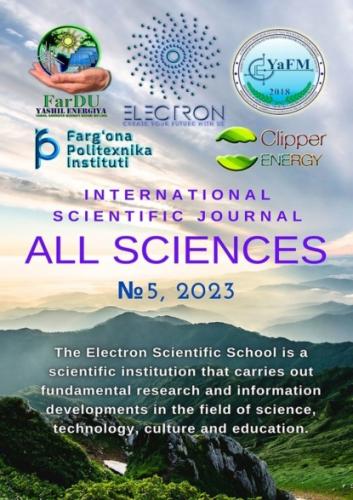International Scientific Journal
Authors: Aliyev Ibratjon Xatamovich, Karimov Boxodir Xoshimovich, Qo'ldashov Obbozjon Xokimovich, Komilov Abdullajon Odiljonovich, Jumayev Javohir Abdurasulovich, Qo'chqorov Ahliddin Mirzohidovich, Xayitov Saidjon Baxtiyorjonovich, Xayitova Maftuna Rahmatillayevna, Obidov Foziljon Oripovich, Usmonova Shaxlo Norqoziyevna
Editor-in-Chief Ibtajon Xatamovich Aliyev
Illustrator Obbozjon Xokimovich Qo'ldashov
Illustrator Sultonali Mukaramovich Abduraxmonov
Cover Designer Ibratjon Xatamovich Aliyev
Cover Designer Ra'noxon Mukaramovna Aliyeva
Acting Scientific Supervisor Sultonali Mukaramovich Abduraxmonov
Economic Manager Farruh Murodjonovich Sharofutdinov
Economic Consultant Botirali Rustamovich Jalolov
Proofreader Gulnoza Muxtorovna Sobirova
Proofreader Abdurasul Abdusoliyevich Ergashev
Proofreader Ekaterina Aleksandrovna Vavilova
© Ibratjon Xatamovich Aliyev, 2023
© Boxodir Xoshimovich Karimov, 2023
© Obbozjon Xokimovich Qo'ldashov, 2023
© Abdullajon Odiljonovich Komilov, 2023
© Javohir Abdurasulovich Jumayev, 2023
© Ahliddin Mirzohidovich Qo'chqorov, 2023
© Saidjon Baxtiyorjonovich Xayitov, 2023
© Maftuna Rahmatillayevna Xayitova, 2023
© Foziljon Oripovich Obidov, 2023
© Shaxlo Norqoziyevna Usmonova, 2023
ISBN 978-5-0060-4653-5 (т. 5)
ISBN 978-5-0059-5900-3
Created with Ridero smart publishing system
PHYSICAL AND MATHEMATICAL SCIENCES
DESIGN AND FEATURES OF THE PROCESS OF CREATING A HELIUM LASER
UDC 621.373.8
Aliyev Ibratjon Xatamovich
3rd year student of the Faculty of Mathematics and Computer Science of Fergana State University
Ferghana State University, Ferghana, Uzbekistan
Annotation. The manufacture of a large number of devices of a very different nature is reduced to the possibility of interaction of modern technology with a variety of types of materials, including refractory ones. For this reason, in order to create a three-dimensional printer device capable of acting on tungsten, quartz and some other materials, by regulating the strength of the melting element, the design of a helium ultraviolet laser was developed.
Keywords: laser, helium, ultraviolet, tungsten, three-dimensional printer, design, device.
Аннотация. Изготовление большого количества устройств самого различного характера сводиться к возможности взаимодействия современной техники с самыми различными типами материалов, в том числе и тугоплавкими. По этой причине, с целью создания устройства трёхмерного принтера способного воздействовать на вольфрам, кварц и некоторые другие материалы, путём регулирования силы плавящего элемента и была разработана конструкция гелиевого ультрафиолетового лазера.
Ключевые слова: лазер, гелий, ультрафиолет, вольфрам, трёхмерных принтер, конструкция, устройство.
The laser device is a cylindrical glass flask with a fixed diameter and an internal division similar to the radius. The thickness of such a bulb is chosen specifically to solve the problem of depressurization of the structure. In such a flask, helium is introduced in the outer part, and coils are installed on both sides, one of which is a direct – filament cathode, and the second is an anode. Due to the fact that the cathode begins to heat up, a current density begins to arise between it and the anode, determined by (1) and from which the kinetic energy of the cathode molecules (2) can be calculated from the temperature value, and after that the velocity of the molecules (3), from which, in turn, the charge is calculated from the value of a certain current density (4).
Further, from the calculations given, it is possible to determine the voltage, that is, the kinetic energy of the charges reaching the anode, from where their voltage (5) manifests itself, and since the value of the current density in the cathode itself (6) is known, depending on the ratio of this current density and the density of the outgoing charge, the percentage of charge output from the cathode can be found (7) or a kind of cathodic efficiency.
After the charges with the set energy, at a given voltage, fly out of the cathode, they begin to affect the helium located between the electrodes, which begins to be excited and move to the next energy level and after descending from it, which takes microseconds, begins to emit photons of ultraviolet light. There is a reflective foil around the outer part of the bulb, which reflects all these multidirectional rays and reduces them to a single point. In addition, mirrors or the same foil are located at the ends of the sides of this tube, which further increases the effect.
Then the reflected ultraviolet rays begin to move towards the central part, but this central part must be made of quartz glass, which unlike conventional conducts ultraviolet. And in the central flask there is also helium with the same excitation energy, which leads to the fact that helium absorbs the photons that hit it and releases twice as much.
On one side of the central part of the structure there is also a reflecting mirror, and on the other – quartz glass, which releases a stream of concentrated ultraviolet photons with high energy. Thus generating a stream with an energy of at least 28—30 watts, which can be concentrated in sufficiently small areas using powerful lenses and acting on the desired object. For comparison, when using a lens with the possibility of increasing by 5.5—6 thousand times and reducing the beam area to 1 micron, the temperature of tungsten reaches 4.5 thousand degrees, which is several times higher than its melting point. Thanks to this, it is possible to create a design of this kind of three-dimensional printer that will affect the material with great accuracy, causing it to melt at a certain point with an accuracy of up to a micrometer and layer by layer causing the formation of the necessary detail of any scale with sufficiently high strength!
Used literature
1. Bagramov, R. Lasers in dentistry, maxillofacial and reconstructive plastic surgery / R. Bagramov, M. Alexandrov, Yu. Sergeev. – M.: Technosphere, 2010. – 608 p.
2. Bertolotti, M. The history of the laser. Scientific publication / M. Bertolotti. – M.: Intellect, 2015. – 336 p.
3. Bogdanov, A.D. Gyroscopes on lasers / A.D. Bogdanov. – M.: Voenizdat, 1975. – 731 p.
4. Vasiliev,
